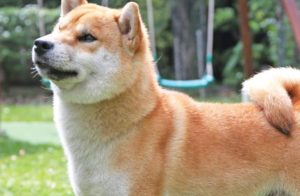The Shiba Inu, Shiba Ken, or simply Shiba, has existed at least since the 3rd century B.C. and was originally bred for hunting, though it is normally raised as a pet. The Shiba Inu nearly became extinct during World War II, but is now experiencing a resurgence of popularity, and a big part of this is due to the “Doge” meme that took the internet by storm starting in 2013.
In the breed standards for this dog, it’s noted that the Shiba Inu is the smallest of native Japanese dog breeds, originally developed for hunting by sight and scent in the dense undergrowth of Japan’s mountainous areas. Alert and agile with keen senses, it is also an excellent watchdog and companion.
“I had no idea what a “Doge” was until I checked Google just now,” says Kirby Ongsue, the happy owner of Bullet, our cover model. “I find it amusing! I think it has had more of a positive effect on the breed’s popularity. People have even sent me cute photos of Shiba Inus trending on the internet, which makes me proud to have Bullet.”
However, despite the internet fame, the National Shiba Club of America claims that interest in Shibas is, in fact, decreasing. The Shiba Inu is actually the domesticated dog genetically closest to a wolf, and it is probably not the breed for most people. “I can understand their frustration with Shiba Inus,” says Kirby. “After Bullet’s first night in my room, I woke up to see remnants of my power strip cable. It was completely destroyed!”
Kirby also says that Bullet destroys flip-flops whenever he sees one near him. “This breed really has a lot of energy and is very curious,” he says, “but this can be compensated for with a lot of play time and toys to divert their attention away from your personal things.”

It’s easy to see, though, why many people would choose to put up with the extra attention that a Shiba Inu requires. “What definitely attracted me to the breed is the cute fox look. Also, the small-to-medium size fits the characteristics I was looking for.”
FAIR WEATHER FRIENDS – The Shiba Inu originated in Japan, so how does it fare in the Philippines’ tropical climate? “Actually,” says Kirby, “I noticed that our climate is a bit too hot for them. They tend not to eat as much, and are not as active when left outside the house for a day. They also don’t grow a nice coat when the weather is too hot for them.”
According to him, Shiba Inus prefer cooler places. “One night, I came home and wanted to play with Bullet, but I noticed that his food hadn’t been touched, and he wasn’t very active. I got really scared and made plans to visit the vet first thing in the morning. I took Bullet to sleep in my room that night, and surprisingly, after the air conditioner got colder, he suddenly perked up, finished his bowl of food and happily ran around!” The coat of a Shiba Inu is actually warmer than it appears, and they shed a lot, like huskies.
CALLING THE SHOTS – Shiba Inus are an independent dog breed, and if they find something that interests them, they won’t listen to your calls. It’s better to keep them on a leash when walking them in open spaces. “They need a patient family that doesn’t give up,” says Kirby. “Shiba Inus are very dominant in nature, and are quite hard to train especially when spoiled. But they are very nice to people and are always approachable. The only instance I’ve ever seen them get mad is when they are playing with other Shiba Inus. They seem to get annoyed with each other’s playfulness.”
Despite their tough and hardy nature, however, Shiba Inus are susceptible to certain health issues. Some develop eye problems, such as cataracts and glaucoma. Also, it is very important to give your Shiba Inu all the shots it needs before walking it outside. “Wolf-like dogs are prone to the parvo virus, which is very deadly to puppies and still dangerous to adult dogs,” says Kirby. “I learned this the hard way: I lost one of my Shiba Inu puppies by walking them outside the house before they were fully vaccinated.”

THIS MAN’S BEST FRIEND – “I grew up surrounded by animals since I was very little,” says Kirby. “My dad also loved animals, and he brought home different kinds of pets. We’ve had dogs all my life, but I never took care of them personally. I’ve had a lot of animal breeding projects since I was little: follower horns, rabbits, stingrays, birds, and cats. After I got Bullet and decided to get him to participate in dog shows, I realized that I needed to learn much more about dog husbandry. I’ve also been to only one big dog show, so far, and I have a long way to go.”
So how do dogs measure up to the other animals? “Dogs are definitely still man’s best friend, and I don’t really consider them just a breeding project, but as a true companion. They definitely take away a lot of stress when you get home and you see them waiting for you.”
A common misconception about Shiba Inus involves Hachiko, the Japanese dog legendary for his loyalty. “Hachiko is actually an Akita, not a Shiba Inu,” explains Kirby. “Akitas are similar-looking Japanese dogs, but are large dogs, while Shiba Inus are only small-to-medium dogs.”
So who is the most famous Shiba Inu? “Now that I know about Doge, that would probably be the most famous,” laughs Kirby.
This story appeared in Animal Scene’s December 2017 issue.






